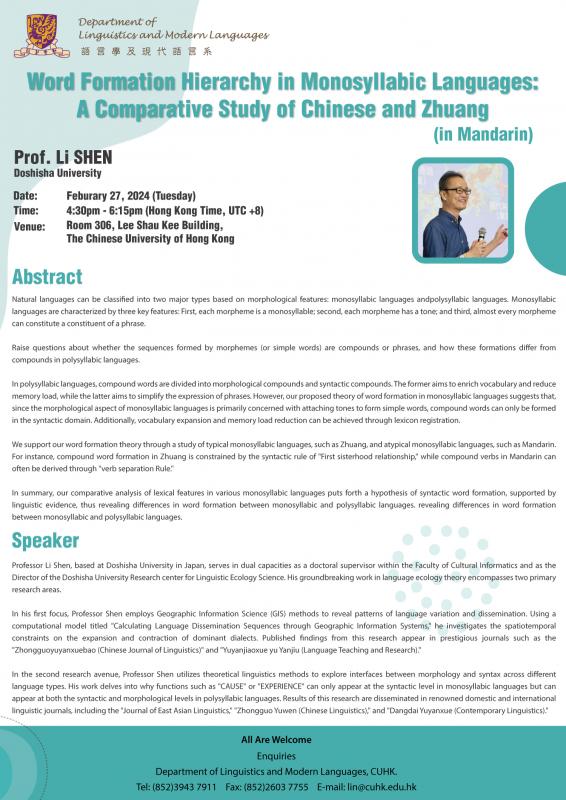讲者简介
Professor Li Shen, based at Doshisha University in Japan, serves in dual capacities as a doctoral supervisor within the Faculty of Cultural Informatics and as the Director of the Doshisha University Research center for Linguistic Ecology Science. His groundbreaking work in language ecology theory encompasses two primary research areas.
In his first focus, Professor Shen employs Geographic Information Science (GIS) methods to reveal patterns of language variation and dissemination. Using a computational model titled "Calculating Language Dissemination Sequences through Geographic Information Systems," he investigates the spatiotemporal constraints on the expansion and contraction of dominant dialects. Published findings from this research appear in prestigious journals such as the "Zhongguoyuyanxuebao (Chinese Journal of Linguistics)" and "Yuyanjiaoxue yu Yanjiu (Language Teaching and Research)."
In the second research avenue, Professor Shen utilizes theoretical linguistics methods to explore interfaces between morphology and syntax across different language types. His work delves into why functions such as "CAUSE" or "EXPERIENCE" can only appear at the syntactic level in monosyllabic languages but can appear at both the syntactic and morphological levels in polysyllabic languages. Results of this research are disseminated in renowned domestic and international linguistic journals, including the "Journal of East Asian Linguistics," "Zhongguo Yuwen (Chinese Linguistics)," and "Dangdai Yuyanxue (Contemporary Linguistics)."

活动概览
Natural languages can be classified into two major types based on morphological features: monosyllabic languages and polysyllabic languages. Monosyllabic languages are characterized by three key features: First, each morpheme is a monosyllable; second, each morpheme has a tone; and third, almost every morpheme can constitute a constituent of a phrase.
Raise questions about whether the sequences formed by morphemes (or simple words) are compounds or phrases, and how these formations differ from compounds in polysyllabic
languages.
In polysyllabic languages, compound words are divided into morphological compounds and syntactic compounds. The former aims to enrich vocabulary and reduce memory load, while the latter aims to simplify the expression of phrases. However, our proposed theory of word formation in monosyllabic languages suggests that, since the morphological aspect of monosyllabic languages is primarily concerned with attaching tones to form simple words, compound words can only be formed in the syntactic domain. Additionally, vocabulary expansion and memory load reduction can be achieved through lexicon registration.
We support our word formation theory through a study of typical monosyllabic languages, such as Zhuang, and atypical monosyllabic languages, such as Mandarin. For instance, compound word formation in Zhuang is constrained by the syntactic rule of "First sisterhood relationship," while compound verbs in Mandarin can often be derived through "verb separation Rule."
In summary, our comparative analysis of lexical features in various monosyllabic languages puts forth a hypothesis of syntactic word formation, supported by linguistic evidence, thus revealing differences in word formation between monosyllabic and polysyllabic languages.
电话:3943 7911
传真:2603 7755
电邮:lin@cuhk.edu.hk


